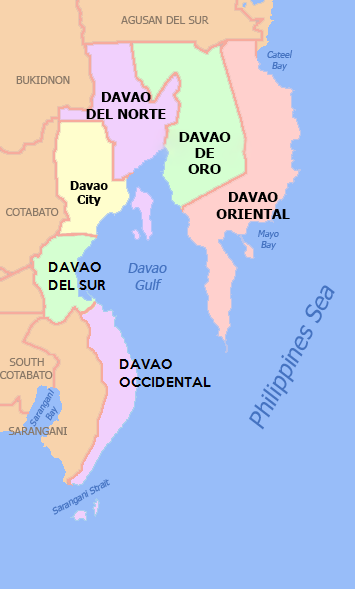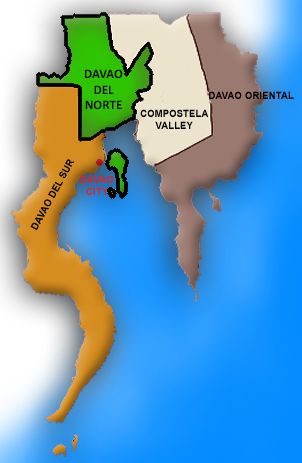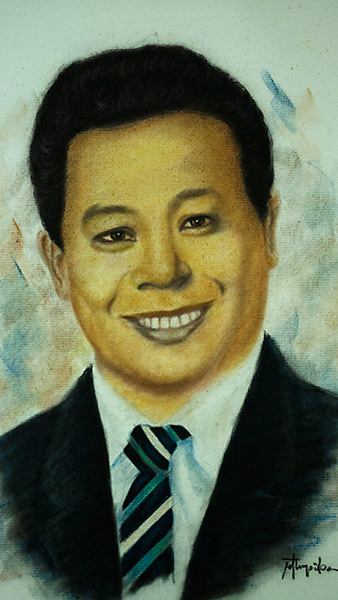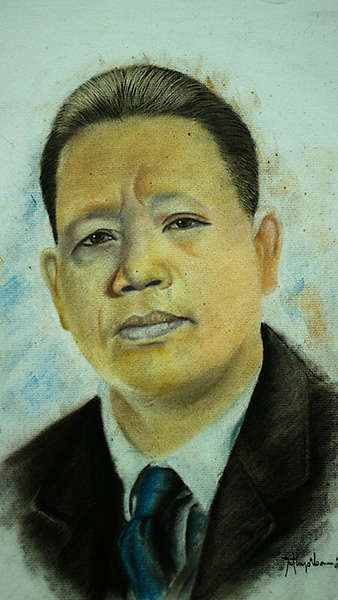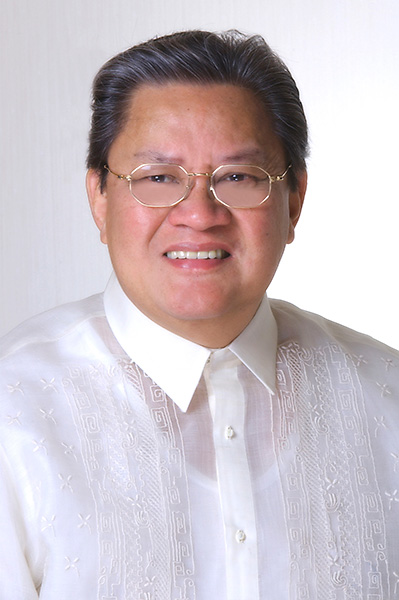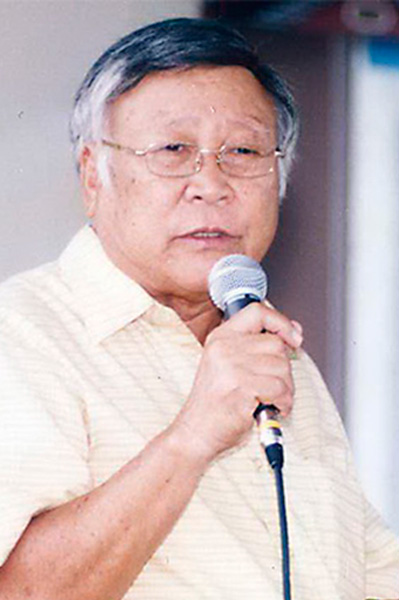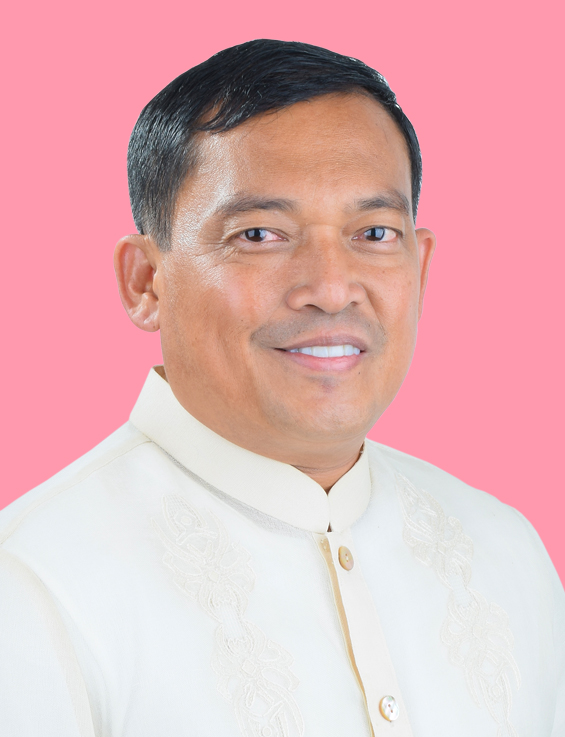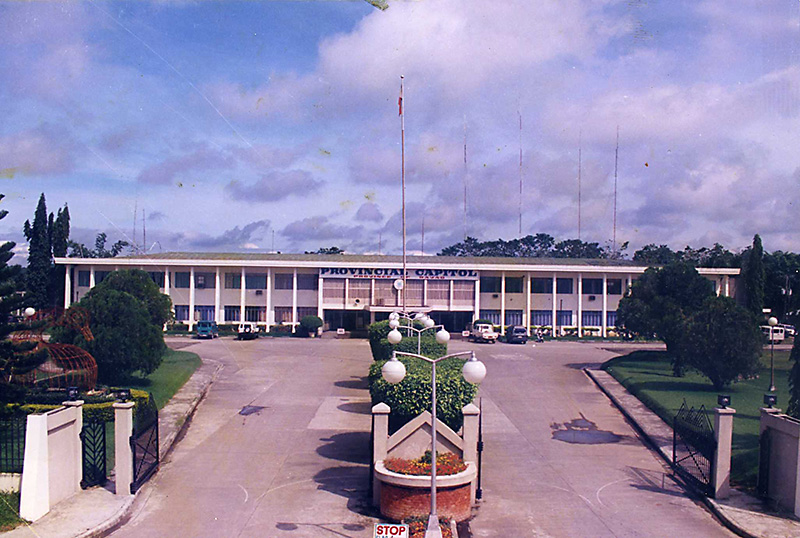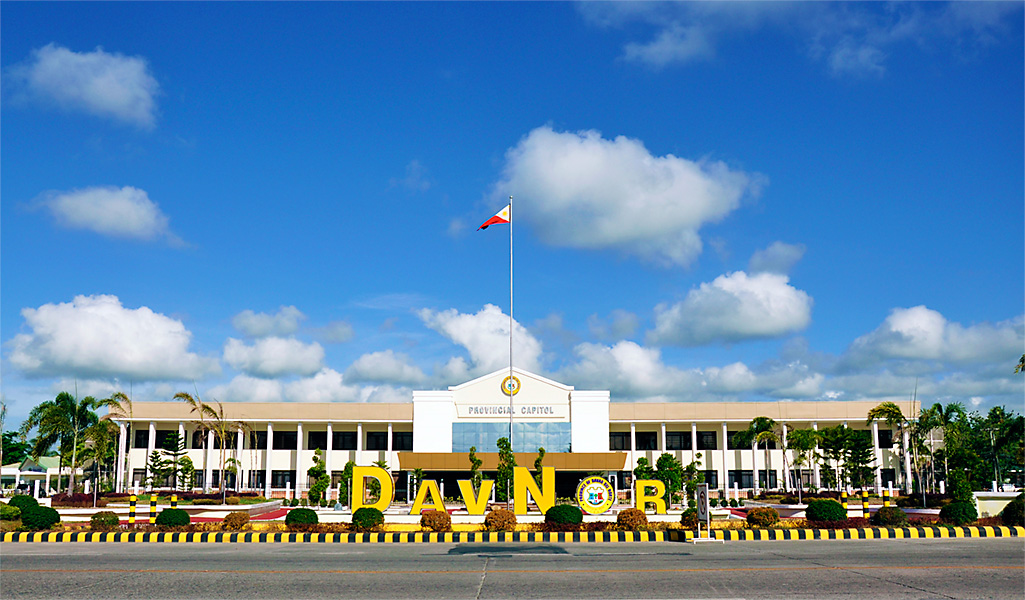Brief History of the Province
The original mother Province of Davao was divided into three (3) provinces, namely: Davao del Norte, Davao del Sur and Davao Oriental by virtue of the bill authored by then Congressman. Hon. Lorenzo S. Sarmiento, Sr., which bill was passed into law and became known as R.A. 4867 dated 8 May 1967. The three provinces simultaneously celebrate their anniversary every 1st of July.
When it was created, Davao del Norte was composed of thirteen (13) municipalities, namely: Asuncion, Babak, Compostela, Kapalong, Mabini, Mawab, Monkayo, Nabunturan, Panabo, Pantukan, Samal, Sto. Tomas and Tagum. Six (6) additional municipalities were created as of May 6, 1970. These were Carmen, Kaputian, Maco, Montevista, New Bataan and New Corella. As of 1996, the province had a total of twenty-two (22) municipalities with the creation of San Vicente (now Laak) in 1979, Maragusan in 1988 and Talaingod in 1990.
The first Governor, Hon. Verulo C. Boiser was appointed by the President. He served the Province for ten years, which was from July 1, 1967 to July 7, 1977. This corresponds to two years as appointed Governor and two terms as elected Governor.
In 1972, during the term of Governor Boiser, the infrastructure development of Davao del Norte was given a big boost when the province qualified among the twenty eight (28) provinces nationwide to be included in the development program of the MLGCD and the United States Agency for International Development (USAID). Under this program, the Province successfully implemented the Rural Roads Program (RRP) for fifteen years and the Barangay Water Program (BWP) for eleven years.
The second Provincial Chief Executive was Governor Gregorio R. Dujali who was also extended a presidential appointment when the first Governor stepped down from the gubernatorial position on July 7, 1977. Like his predecessor, Governor Dujali also served Davao del Norte as the appointed governor for one year and as an elective governor for two terms until March 31, 1986.
During the term of office of Governor Dujali, agricultural endeavors of the provincial government gained prominence. One of the significant projects was the "Pagkain ng Bayan", a demonstration/model rice farm administered by the provincial government, which also generated income for the province. This economic enterprise was later expanded to include the production of other agricultural products. The "Pagkain ng Bayan" site has been the venue of several trainings jointly sponsored by the Japan-based Organization for Industrial, Spiritual and Cultural Advancement (OISCA) and the Province of Davao del Norte.
Under the Dujali administration many people in the province had availed themselves of agricultural livelihood projects.
On February 25,1986, Her Excellency, Mrs. Corazon C. Aquino was installed as President of the Philippines by virtue of the "People Power" otherwise known as the EDSA Revolution. Davao del Norte was among the local government units that experienced a change of officials.
Hon. Prospero S. Amatong was appointed as the OIC-Governor of Davao del Norte on April 4, 1986. Together with him, six board members were also appointed, but four of them resigned when they ran for congressional positions. Consequently, four new members of the Provincial Board were appointed to fill in the vacancies.
The administration of Governor Amatong ushered in a new style of leadership. His untiring close supervision on the implementation of infrastructure projects resulted to the completion of several buildings, roads and bridges.
It was also during the term of Governor Amatong when the peace and order situation greatly improved. Owing to the cease-fire that resulted to the mass surrender of insurgents, a rehabilitation center for rebel returnees was established and these returnees were given the opportunity to earn a living through livelihood projects.
In his bid for the 1988 election, Governor Amatong resigned from his appointive position on November 30, 1987. The Chief Local Government Officer of the Department of Interior and Local Government (DILG), Davao del Norte, Mr. Romeo S. Jardenico took over as OIC Governor for two weeks until the appointment of Atty. Jesus T. Albacite as OIC Governor. However, the term of OIC Governor Albacite was shortlived, lasting only for twenty one (21) days when due to certain constitutional provisions, the position of OIC Governor was extended to Hon. Cecilia de la Paz.
On February 3, 1988, Governor Prospero S. Amatong took his oath as the new governor of Davao del Norte.
During the term of office of Governor Amatong, the economic development of the Province of Davao del Norte had been greatly enhanced as more projects were implemented. Davao del Norte was one of the pilot provinces for the decentralization program which were granted financial assistance by the national government termed as Block Grant in the amount of P120 Million for social, agricultural and infrastructure development.
The administration of Governor Amatong marked the turning point in the implementation scheme for the construction and maintenance of roads and bridges. Since the province had purchased heavy equipment, the contractors were no longer involved in the implementation of roads and bridges. The Governor himself conducted actual visits to the projects to ensure that these were properly implemented.
With the implementation of R.A. 7160 or the Local Government Code of 1991, Non-Government organizations like the cooperatives were involved in government endeavors. This partnership between government and non-government organizations in the pursuit of development was contributory in hastening the progress of the province and in achieving a better quality of life for the people of Davao del Norte.
The same Local Government Code inspired Governor Amatong to pursue the implementation of the first ever reorganization of employees in the provincial government on December 16, 1991. This reorganization has rightfully placed the structure and functions of every office in a proper perspective that is more responsive and supportive to local government services delivery. Still with RA 7160, devolution of functions of a number of national government agencies to the provincial government was made possible.
Among the highlights of achievement under the leadership of Gov. Prospero S. Amatong were the three Galing Pook Awards received for three (3) consecutive years by the Province of Davao del Norte from the Asian Institute of Management and the Department of the Interior and local Government. The said award was given for having excelled in its agricultural program in 1995 and 1996 and its health program in 1997. These were the 1995 Trichogramma; 1996 Sustainable Food Security Program and the 1997 Blood Sufficiency Program.
Considering these prestigious awards received for three (3) consecutive years, Davao del Norte was included in the Hall of Fame for which it was awarded another plaque.
On January 30, 1998, President Fidel V. Ramos signed Republic Act No.8470 creating the Province of Compostela Valley out of Davao Province. Other historical events that transpired in Davao del Norte together with the creation of Compostela Valley were: the enactment of Republic Act No. 8471, creating the Island Garden City of Samal comprising the former municipalities of Babak, Samal and Kaputian; Republic Act No. 8472 converting Tagum municipality into Tagum City, the seat of the provincial government of Davao del Norte Province; and Republic Act 8473 creating the municipality of Braulio E. Dujali from the municipalities of Carmen and Panabo are components of Davao del Norte province. In the turn of events, the province had a political composition of eight municipalities and two cities with 223 barangays.
The term of Governor Prospero S. Amatong ended on March 26, 1998 when he took his Oath of Office as Governor of the newly created province of Compostela Valley on the same day.
The national and local election period from April 1 to June 30, 1999 necessitated the appointment of interim provincial officials headed by Hon. Anecito M. Solis as the Acting Governor.
Hon. Rodolfo P. del Rosario was elected and sworn into office as the first Governor of the new Davao del Norte Province on July 1, 1998.
His leadership concerns were on programs for poverty alleviation and sustainable development. His priority programs were the protection and preservation of our natural resources, human resource development to include education, health and employment generation, cooperative development and the review and modification of the financial policy of the province.
Gov. del Rosario institutionalized the "Cluster Development" approach that grouped municipalities and cities for better developmental complementation.
Subsequently, on March 31, 2001 the Municipality of Panabo was converted into a by virtue of Republic Act 1015. This changed the administrative composition of Davao del Norte to seven municipalities and three cities. Honorable Congressman Antonio R. Floirendo, Jr. sponsored the bill creating the City of Panabo.
One of the remarkable features of good governance exemplified under the leadership of Gov. Rodolfo P. del Rosario is the bonding together of the elected provincial officials into an organization known as "Hugpong Dabaonon" wherein said officials made a commitment to work together, setting aside political affiliation and ideological differences. This manifestation of unity and solidarity is instrumental in effecting the fast pace of development in Davao del Norte.
Priority programs and projects in his time were the Integrated Water Resource Development Project where a feasibility study was made on the potable water supply in the province; the establishment of the Technology and Livelihood Development Center (TLDC) launched in 1999; the Davao del Norte Investment Promotion Center (DNIPC) aimed at increasing investment/business opportunities; the "Medicare para sa Masa" program; the Nutrition Program; the Surgical Outreach Program and the opening of the Carmen District Hospital; "Luntiang Paraiso" rehabilitation center for drug dependents in New Corella; the Sports Development Program and the full support for the Summer Program for Employment of Students (SPES).
Economic services anchored on the MBN concept included projects such as the Infrastructure Project for the Enhancement of Rural Productivity (IPERP), livestock production and animal dispersal projects, the Community-Based Forest Resource Management Project, the Coastal Resource Management Project and the Upland Development Program.
Another landmark, the "Tahanan ng Punong Lalawigan", the official residence of the Provincial Chief Executive of Davao del Norte, was constructed within the compound of the provincial government center.
As member of the Davao Integrated Development Program (DIDP) major economic projects such as farm-to-market roads and Upland Farming Model Villages were realized.
On March 15, 2004, a new municipality was born. Republic Act No. 9265 created the Municipality of San Isidro, the eighth municipality of Davao del Norte. This municipality compises 6 barangays culled out from the Municipality of Kapalong and 7 barangays culled out from the Municipality of Asuncion. The bill was sponsored by Cong. Arrel R. Olano of District I. The seat of this new local government unit is in Barangay Sawata. Governor Rodolfo P. del Rosario served for two terms only. His decision not to run for re-election paved the way for Hon. Gelacio P. Gementiza, Mayor of Tagum City to run for governor of Davao del Norte. His landslide victory gave him a new mandate to head as the governor of the Province of Davao del Norte.
The centerpiece program of government of Governor Gementiza is the social services development and peace and order stability of Davao del Norte. In his inaugural address he pledged to continue the implementation of on-going programs and projects geared towards attaining poverty alleviation through the MBN approach.
During the 2007 election, Governor Rodolfo P. del Rosario decided to run again and won the race against Governor Gementiza.
In his second time around, he leads the province with a much deeper purpose and commitment as he laid down his centre-piece of governance, the "RDR WHEELS" that spells out his strategic goals, development thrusts and directions, to wit:
R- Roads and Infrastructure Development
D- Development of Cooperatives in all sectors
R- Reforms in Governance and Peace and Order
W- Water and electricity development
H- Health, Housing, Sanitation and Social Services
E- Economic Development and Environment Protection/Rehabilitation
E- Education, Culture, Sports and Human Development
L- Livelihood and Skills Development Program
S- Spiritual and Moral Recovery Program
After his unopposed bid for re-election in 2010, Governor del Rosario veered from “RDR WHEELS” ‘s focus on hard infrastructure to soft infrastructure with the aim of “putting a human face development. As a center-piece of development, PEOPLE stands for:
P - eople Empowerment
E - ducation
O- ptimum Health and Social Services
P - ublic-private partnership
L - ink to the world
E - mployment and livelihood opportunities.
In his last term of office, Governor Rodolfo P del Rosario gave his steadfast commitment to deliver effectively and efficiently the programs, projects and activities under his development agenda, PEOPLE, that champions change beyond politics.
The end of term of Governor Rodolfo P. del Rosario on June 30, 2016 also marked the beginning of the term of office of his son, Governor Antonio Rafael G. del Rosario on July 1, 2016. The past administration had ably prepared the Dabaonons, the province’s resources and institutions for the eminent globalization and climate change. The new administration vows to expand the human development agenda with the resolve to promote the Äbilidad at Malasakit”brand of governance.
“Äbilidad” stands for competitiveness Cluster, which include the Economic and Governance Sectors. On the other hand, “Malasakit” makes up the Welfare Group that covers the Environment and Social Sectors. “Äbilidad at Malasakit” involves raising the competitiveness of our people and institutions to effectively adjust to globalization while creating a close-knit, caring community in providing welfare provision for the poorest of the poor so that they too can lead decent lives.
The strategies of “Abilidad at Malasakit” subsumes the B.E.S.T. P.E.O.P.L.E Development Agenda, which spells out as follows:
Significant Accomplishments of Governor Rodolfo P.del Rosario under his development agenda: PEOPLE
People Empowerment
Under the Australian-funded Provincial Road Management Facility (PRMF) and the Philippine Australia Human Resource and Organizational Development Facility
- Hastened institutional reforms and enhanced the local governance structure.
- Introduced interventions which improved processes and systems, and introduced innovations in service delivery, such as: Fast and Accurate Processing of Claims (FAPC), e-budgeting, e-procurement, automated communication system, geographic information system (GIS), Human Resource Information System (HRIS) and Socioeconomic Profiling System (SEPS) Online.
- Sent 31 scholars for graduate studies in Australian Universities.
- Implemented the Strategic Performance Management System, a scientific assessment on organizational and collective performances.
- Institutionalized a human resource development (HRD) system that enabled the province to ascend from Level I (Transactional) to Level II (Transformational) in the PRIME-HRM.
- Received the Seal of Good Local Governance for satisfying the core assessments on good financial housekeeping, disaster preparedness, social protection, and peace and order.
- Garnered a high score in the Agency Procurement Compliance and Performance Indicators (APCPI) for speed, accuracy, transparency and accountability in the procurement process.
- Achieved a major breakthrough in fiscal management by hitting the P 1.082 Billion annual budget in 2014, while reducing by 5% our IRA dependency having realized P 153 Million total local income.
- Implemented the Enhanced Tax Revenue and Collection System (E-TRACS) with extensive information and education campaign have significantly increased the real property tax collection by 12%.
- Completed P210.1 Million worth of projects consisting of public buildings, water systems, roads, bridges, drainage and electrification, while projects worth P 83.5 Million are still on-going province-wide.
Education and Environment
- Increased the allocation to P36.4 Million in support of various education programs and projects that include support for elementary and secondary education, local school board, alternative learning system, sports development program, Madrasah education, and culture and the arts.
- Completed 91 school buildings worth P309 Million.
- Allocated P 6.9 Million for the scholarship program and other projects which benefitted the youth in the province.
- Conducted through the Davao del Norte Technology and Livelihood Center (DN-TLDC) 30 institutional trainings for business enterprises and livelihood programs; 12 trainings for indigenous people communities; and 33 trainings for various non-government organizations.
- Established the Davao del Norte Learning Institute (DNLI) for the Continuing Education Program that enabled provincial employees to earn college degrees and upgrade their academic qualification and service delivery skills. The first batch are 30 employees who graduated with the degree Bachelor in Public Administration. So far, this opportunity had been extended to employees in the component cities and municipalities.
- Achieved the biggest enrollment of Lumads at 14,536 in the Special Education Program, which is that Alternative Learning System for Indigenous People (ALS-IP).
- Oplan A.N.D.A.M. cum Brigada Eskwela at the opening of classes has made schools more disaster-ready and resilient.
- Launched the Talaingod DavNor Runners, a unique sports development program that is focused on the inherent physical prowess of Lumad children. Thus, Davao del Norte is known as the running center in the country.
- Participated in the Mindanao “TreeVolution”, which gained the Guiness Book of World Records. In Davao del Norte, participating 15,924 planters have planted 306,541 seedlings.
- Implemented an intensive reforestation across the LGUs under the National Greening Program in partnership with private entities and communities.
- Enforced forest protection laws and achieved a 13% increase in accomplishments with the confiscation of 413.82 cu.m. of illegally cut and transported forest trees.
- Intensified the riverbank protection program under Oplan A.N.DA.M.
- Capacitated the LGUs to advance pollution control, proper solid waste management.
Optimum Health and Social Services
- Expanded the Phil Health Program to those belonging to the low income bracket such as the trisikad drivers, fisherfolks, Barangay Police Action Team (BPATS) members and Gawad Kalinga beneficiaries as well as those in prison and their families.
- Enhanced the capacity of the 3 Provincial Hospotals to operate 24/7 in health care services such as OPD, emergency Room, Laboratory, Pharmacy,Auxillary and In-patient Department, Operating Room and Delivery Room Sections.
- Reduction in malnutrition rate to 4.76% from 4.86% and had been a consistent recipient of the Green Banner Award and Regional Outstnading Winner in Nutrition.
- Intensified Malaria Control and was declared by the Department of Health as a Filariasis-free province.
- Implemented the Tobacco Prevention and Control Program and launched the Provincial Smoking Cessation Clinic in 2014. Thus, received the Red Orchid Award from the Department of Health in 2014.
- Provided support and incentives to Day Care workers: P 5,000.00 retirement benefit and P 5,000.00 mortuary benefits. Davao del Norte had the most number of Day Care Centers in Region XI.
- Partnered with educational institutions and TESDA to develop the creative skills of Persons with Disabilities (PWDs) to enable them to keep up with the society.
- The implementation of DSWD programs enabled the province to receive the distinction as the region’s Model LGU and the Gawad Parangal for Local Executives category from the Association of Local Social Welfare and Development Officers of the Philippines.
Public-Private Partnership
- Completion of the Davao del Norte Sports and Tourism Complex, the site of the successful hosting of the best-ever Palaro has caught national attention. The complex highlights the province’s potential as a MICE (meetings, incentives, conferences and exhibitions) destination.
- Upgrading of hospitals through the procurement of laboratory equipments, i.e.hematology and serum electrolyte machine which increased income from laboratory fees by 32% and from laboratory procedures by 14.5%.
- Outsourcing of hospital utility personnel for a well-maintained and cleaner hospital environment as well as effective infection control.
- Harnessed the private sector in disaster preparedness and response protocol particularly during the onset of calamities.
- Facilitated the P5.7 Billion seaport and container yard project of the Hijo International Port Services, Inc.; the P2.7 Billion mall project of the Robinsons Land Corporation; P2.6 Billion international container terminal of the Aflocor-owned San Vicente Terminal and Brokerage Services in Panabo City; and the P116.2 Million Oakwood Residences undertaken by the HLC Construction and Development Corporation in Panabo City.
- The province passed the Davao del Norte Public-Private Partnership (PPP) Code, a significant law that signifies our readiness for the eminent ASEAN integration.
Link to the World
- “DavNor Karon” newspaper was created as a medium of information to keep people aware of development-related news in the province. Such information is also made available online through the province’s website.
- Some 471.63 kilometers provincial road in good condition are being closely monitored by the Provincial Monitoring Committee (PMC) to assure greater accessibility of people to social services.
- Tourism as a link to the world was enhanced through the implementation of support infrastructures to priority destination sites, namely: a) Talikud Island as model for sustainable open-beach destination under the Local Governance support Program for Local Ecocnomic development (LGSP-LED) Project; b) Concreting of seawall and embankment in Cagangohan, Panabo City; c) access to Panas Water Falls (New Corella) and Suaon Nature Park (Kapalong).
- Established the Local Tourism Industry Development Program (LTIDP).
- Enactment of the Provincial Tourism Code and the Provincial Investment Incentives Code.
Employment and Livelihood
- Capacitated the Davao del Norte Investment Promotion center (DNIPC) and the Davao del Norte Technology and Livelihood Development Center (DN-TLDC) to provide assistance from product identification and development to marketing and promotion.
- Established the “Magnegosyo Ta”Program that provides small and medium enterprises free orientation, livelihood trainings and demonstrations.
- Established the “Pasalubong” Center as marketing support to local products, particularly those “Öne Town, One Product” commodities.
- Supported campaigns for local products to enter international markets.
- Supported the Davao del Norte Credit Surety Fund, thus, facilitated the release of loans to 200 farmers and entrepreneurs amounting to P 21.5 Million.
- Supported the Organic Farming and System Rice Intensification Program, which reduced farm production cost by 11 percent.
- Received the recognition as Davao Region’s Top Performing Province in implementing the Organic Agriculture Program.
- Supported the Cereals Enhancement Program that increased the rice sufficiency level by 10 percent.
- Supported the Livestock and Poultry Production Program, which improved the production of fast growing, feed efficient, high value and disease resistant animals.
- The province had started the operation of the frozen goat semen processing laboratory in Kapalong, the only one of its kind in Davao Region.
Seal of Good Local Governance (SGLG)
- During the administration of Governor Rodolfo P. del Rosario that the province attained the Seal of Good Local Governance that covered the areas of good financial housekeeping, disaster preparedness, social protection, business friendliness and competitiveness, and peace and order.
Disaster Preparedness : CCA-DRRM
- Climate Change Adaptation and Disaster Risk Reduction Management (CCA-DRRM) was put in place, while Oplan A.N.D.A.M. (Advocacy on Natural Disaster Awareness and Management was launched to promote a culture of safety and a more resilient Dabaonons. Some P 53 Million was allotted to support DRRM projects and activities.
Policy Direction
- Adopted the performance reward system to capitol employees through the Productivity Enhancement Incentive (PEI).
- Supported all efforts to achieve the Millenium Development Goals (SDGs).
- Initiated the formulation of a feasibility study of the proposed Samal Bridge, the Talikud Island Development and the completion of the coastal Road from Panabo City to the Municipality of Carmen.
- Supported the Localized and Integrated Programs and Approaches for Development through Ugmad Komunidad (LIPAD-UK) Program in Cagangohan, Panabo City.
On 2019 election, Governor Edwin I. Jubahib won the race against Governor Anthony del Rosario.
The unprecedented change that swept across the local landscape marked the advent of a new era for Davao del Norte. It enabled the province to soar to fresh milestones in attaining higher growth, as well as faster and more inclusive socio-economic advancement.
Governor Jubahib, assume the very important role of a first-born son in helping provide for the needs of the family. He would like to be remembered as a loving big brother to all Dabaonon brethren. One who afforded safe refuge, a nurturer, a role model, a protector and a mediator, among other endearing traits of an older brother. Rooting on the endearing qualities of a big brother, he crafted the development agenda, known as K.U.Y.A. G.O.B. This is spelled as:
K- Knowledge Management, Education and Sports;
U- Universal Health and Social Services;
Y- Yield Growth in Agriculture and Environmental Sustainability;
A- Adequate Infrastructure and Facilities;
G- Greater Livelihood and Income Opportunities;
O- Operational Peace and Development Framework;
B- Broad-Based Economic growth and Investments.
The K.U.Y.A G.O.B. development agenda is consistent with the thrusts and priorities of President Rodrigo R. Duterte, as it is also clearly anchored on the Ambisyon Nation 2040. This is the long term vision of the national government to end poverty in the country by 2040. The 25 year vision, which reflects the ordinary Filipinos’ desire to pursue a middle-class and family-centric life, is perfectly in harmony with family-oriented strategy. Hence, with the K.U.Y.A G.O.B. approach, the Province “localized” the vision for Filipinos to live “long and healthy lives”, being smart and innovative, and living in a “high trust society”.
The List of Provincial Officials
Province of Davao del Norte
From 1968 to 2019
CY 1968-1971 (Presidential Appointment)
Governor: Hon. Verulo C. Boiser
Vice Governor: Hon. Cecilia A. de la Paz
Board Members: Hon. Ruperto C. Garcia, Hon. Candido M. Perales, Hon. Dominador F. Selga
CY 1971 – 1974
Governor: Hon. Verulo C. Boiser
Vice Governor: Hon. Cecilia A. de la Paz
Board Members: Hon. Ruperto C. Gonzaga, Hon. Candido M. Perales, Hon. Rolando C. Marcial
CY 1974 – 1977
Governor: Hon. Verulo C. Boiser
Vice Governor: Hon. Cecilia A. de la Paz
Board Members: Hon. Ruperto C. Gonzaga, Hon. Candido M. Perales, Hon. Rolando C. Marcial
CY 1977 – 1980 (Presidential Appointment)
Governor: Hon. Gregorio R. Dujali
Vice Governor: Hon. Cecilia A. de la Paz
Board Members: Hon. Ruperto C. Gonzaga, Hon. Rolando C. Marcial, Hon. Candido M. Perales
CY 1980 – 1983
Governor: Hon. Gregorio R. Dujali
Vice Governor: Hon. Gelacio P. Gementiza
Board Members: Hon. Rolando C. Marcial, Hon. Ruperto C. Gonzaga, Hon. Maximo M. Nuñez, Hon. Candido M. Perales, Hon. Virgilio C. Boiser, Hon. Artemio V. San Juan, Hon. Constancio M. Fernando, Hon. Salvador N. Rodriguez (KB)
CY 1983 – 1986
Governor: Hon. Gregorio R. Dujali
Vice Governor: Hon. Gelacio P. Gementiza
Board Members: Hon. Rolando C. Marcial, Hon. Ruperto C. Gonzaga,Hon. Candido M. Perales, Hon. Virgilio C. Boiser, Hon. Artemio V. San Juan, Hon. Bienvenida M. Royo, Hon. Maximo C. Nuñez, Hon. Salvador N. Rodriguez (KB)
CY 1986 – 1987 (Presidential Appointment)
Governor: Hon. Prospero S. Amatong
Vice Governor: Hon. Jose R. Caballero
Board Members: Hon. Margarito M. Cualing, Hon. Crisanto D. Maniwang, Hon. Rey T. Uy, Hon. Pedro B. San Jose, Hon. Versim A. Enad, Hon. Providencia P. Nuñez, Hon. Virgilio C. Boiser, Hon. Artemio V. San Juan, Hon. Rodolfo C. Bautista, Hon. Bienvenida M. Royo, Hon. Anecito S. Solis, Hon. Elmer B. Jampayas (KB)
CY 1988 – 1992
Governor: Hon. Prospero S. Amatong
Vice Governor: Hon. Jose R. Caballero
Board Members: Hon. Crisanto D. Maniwang, Hon. Rey T. Uy, Hon. Pedro B. San Jose, Hon. Versim A. Enad, Hon. Providencia P. Nunez, Hon. Anecito A. Solis, Hon. Artemio V. San Juan, Hon. Rodolfo C. Rapista, Hon. Virgilio C. Boiser, Hon. Antonio R. Floirendo, Jr. (FABC)
CY 1992 – 1995
Governor: Hon. Prospero S. Amatong
Vice Governor: Hon. Gelacio P. Gementiza
Board Members: Hon. Margarito M. Cualing, Hon. Pedro B. San Jose, Hon. Virgilio C. Boiser, Hon. Artemio V. San Juan, Hon. Manuel E. Zamora, Hon. Providencia P. Nuñez, Hon. Aniceto S. Solis, Hon. Eulogio L. Grasparil, Hon. Fortunato A. Dayot, Hon. Michael O. Galicia, Hon. Antonio R. Floirendo, Jr. (FABC), Hon. Julio B. Abenales (PCL ), Hon. Maria Carmen S. Zamora (SKF)
CY 1995 – 1998
Governor: Hon. Prospero S. Amatong
Vice Governor: Hon. Pedro B. San Jose
Board Members: Hon. Manuel E. Zamora, Hon. Artemio V. San Juan, Hon. Michael O. Galicia, Hon. Aniceto S. Solis, Hon. Eulogio L. Grasparil, Hon. Rey T. Uy, Hon. Rogelio E. Israel, Hon. Virgilio C. Boiser, Hon. Shirley Belen R. Aala, Hon. Damasceno A. Aguirre, Hon. Florante E. Garcia (PCL Pres), Hon. Antonio R. Floirendo, Jr. (FABC Pres: July 1997-June 1998), Hon. Ramil L. Gentugaya (SKF Pres: July 1997-June 1998)
April1-June 30, 1998 Interim Officials
Governor: Hon. Aniceto M. Solis
Vice Governor: Hon. Virgilio C. Boiser
Board Members: Hon. Daniel B. Turan, Hon. Jose L. Silvosa, Hon. Gaspar G. Valera, Hon. Maximo M. Estela, Hon. Prospero H. Estabillo, Hon. Providencia P. Nuñez
CY 1998 – 2001
Governor: Hon. Rodolfo R. del Rosario
Vice Governor: Hon. Gelacio P. Gementiza
Board Members: Hon. Rogelio E. Israel, Hon. Arrel R. Olaño, Hon. Alan D. Zulueta, Hon. Meliton D. Lemos, Hon. Rodolfo C. Rapista, Hon. Maximo M. Estela, Hon. Jose D. Silvosa, Sr., Hon. Gaspar R. Valera, Hon. Eulogio L. Grasparil, Hon. Hernanie L. Duco, Hon. Macario A. Bermudez II (PCL Pres), Hon. Antonio R. Floirendo, Jr. (FABC Pres:Jan-June 1998), Hon. Noel L. Tabacon (FABC Pres: July 1998-Dec 2001), Hon. Ramil L. Gentugaya (SKF Pres: Jan-June 1998), Hon. Nieljun C. Esdrelon (SKF Pres : July 1998-July 2001)
CY 2001-2004
Governor: Hon. Rodolfo P. del Rosario
Vice Governor: Hon. Victorio R. Suaybaguio, Jr.
Board Members: Hon. Rogelio E. Israel, Hon. Maximo M. Estela, Hon. Jose D. Silvosa, Sr., Hon. Alan D. Zulueta, Hon. Hernanie L. Duco, Hon. Shirley Belen R. Aala, Hon. Franklin D. Gentiles, Hon. Macario A. Bermudez II, Hon. Gaspar R. Valera, Hon. Antonio M. Lagunsad, Hon. Alan R. Dujali (PCL Pres), Hon. Noel L. Tabacon (FABC Pres: Jan-Oct 2002), Hon. Antonio Rafael G. del Rosario (FABC Pres: Nov 2002-June 2004), Hon. Nieljun C. Esdrelon (FABC Pres), Hon. Kim P. Quesada (SKF Pres: 2002-2004)
CY 2004 – 2007
Governor: Hon. Gelacio P. Gementiza
Vice Governor: Hon. Antonio Rafael G. del Rosario
Board Members: Hon. Hernanie L. Duco, Hon. Franklin D. Gentiles, Hon. Shirley Belen R. Aala, Hon. Salvador R. Royo, Hon. Meliton D. Lemos, Hon. Gaspar R. Valera, Hon. Alan D. Zulueta, Hon. Macario A. Bermudez II, Hon. Emelita A. Alvarez, Hon. Jose D. Silvosa, Sr., Hon. Rogelio E. Israel (PCL Pres), Hon. Neiljun C. Esdrelon (FABC Pres), Hon. Kim P. Quesada (SKF Pres)
CY 2007 – 2010
Governor: Hon. Rodolfo P. del Rosario
Vice-Governor: Hon. Victorio R. Suaybaguio, Jr.
Board Members: Hon. Janet G. Gavina, Hon. Rogelio E. Israel, Hon. Salvador R. Royo, Hon. Macario A. Bermudez, II, Hon. Gregorio S. Facula, Hon. Artemio V. San Juan, Hon. Antonio M. Lagunzad, Hon. Ely C. Dacalus, Hon. Leopoldo A. Monteroso, Sr., Hon. Jose Recarido P. Federiso, Hon. Demetrio C. Maligro (FABC), Hon. Helario T. Caminero (PCL), Hon. Dennis C. Café (SKFP)
CY 2010-2013
Governor: Hon. Rodolfo P. del Rosario
Vice-Governor: Hon. Victorio R. Suaybaguio, Jr.
Board Members: Hon. Shirley Belen R. Aala, Hon. Raymond Joey D. Millan, Hon. Vicente C. Eliot, Sr., Hon. Antonio M. Lagunzad, Hon. Alfredo D. De Veyra, Hon. Janet G. Gavina, Hon. Daniel A. Lu, Hon. Alan R. Dujali, Hon. Ely C. Dacalus, Hon. Hernanie L. Duco, Hon. Janrey G. Gavina (PCL), Hon. Vicente R. Floirendo (FABC), Hon. Eugene Katrina R. Estrada (SKPFP)
Congressmen: Hon. Antonio Rafael G. del Rosario - District I, Hon. Antonio F. Lagdameo, Jr. - District II
CY 2013-2016
Governor: Hon. Rodolfo P. del Rosario
Vice-Governor: Hon. Victorio R. Suaybaguio, Jr.
Board Members: Hon. Shirley Belen R. Aala, Hon. Raymond Joey D. Millan, Hon. Vicente C. Eliot, Sr., Hon. Alfredo D. De Veyra, Hon. Robert L. So, Hon. Janet G. Gavina, Hon. Alan R. Dujali, Hon. Hernanie L. Duco, Hon. Ely C. Dacalus, Hon. Ernesto T. Evangelista
Congressmen: Hon. Antonio Rafael G. del Rosario - District I, Hon. Antonio F. Lagdameo, Jr. - District II
CY 2016-2019
Governor: Hon. Antonio Rafael G. del Rosario
Vice-Governor: Hon. Alan R. Dujali
Board Members: Hon. Shirley Belen R. Aala, Hon. Alfredo B. De Veyra III, Hon. Vicente C. Eliot, Sr., Hon. Raymond Joey D. Millan, Hon. Francisco C. Remitar, Hon. Rodolfo G. del Rosario, Jr., Hon. Roy J. Catalan, Hon. Ernesto T. Evangelista, Sr., Hon. Hernanie L. Duco, Hon. Jannet Tanong-Maboloc, Hon. Miguel P. Niez, Hon. Dan P. Gervacio, Hon. Victor M. Pandian
Congressmen: Hon. Pantaleon D. Alvarez - District I, Hon. Antonio D. Floirendo, Jr. - District II
CY 2019-2022
Governor: Hon. Edwin I. Jubahib
Vice-Governor: Hon. Rey T. Uy
Board Members: Hon. Robert L. So, Hon. Nicandro T. Suaybaguio, Jr. UAP, Hon. Francisco C. Remitar MDMG, Hon. Prospero E. Estabillo, Jr., Hon. Roger A. Laguna, Hon. Jannet Tanong-Maboloc, Hon. Franklin D. Gentiles, CE, Hon. Roy J. Catalan, Hon. Janris Jay G. Relampagos, Hon. Denise Marianne A. Lu, MD, Hon. Dindo C. Parangan, Hon. Silvino P. Matobato, Jr. PTRP, Hon. Emerson Dave A. Silutan LPT, Hon. Datu Ariel S. Macla
Congressmen: Hon. Pantaleon D. Alvarez - District I, Hon. Alan R. Dujali, MPA - District II
The Provincial Capitol - The Seat of the Provincial Government
After the creation of the province when there was no capitol building yet, the province established its offices on the mezzanine floor and in the space below the grandstand of an old municipal gymnasium which was located right at the back of the Municipal Hall of Tagum. Other provincial offices were located in the Ymalay and Cervantes buildings along Mabini St.
The building construction of the capitol started in 1969 in the 20-hectare capitol site which was donated by the following land owners: Mr. Quirino Salcedo Magsanoc, Mrs. Margarita Magsanoc Aala, Mr. Pablo Laude Aala, Mrs. Thelma Aala Still, Engr. Richie Magsanoc Aala, Engr. Crisanto Magsanoc Aala, Mrs. Urduja Aala Julopzinen and Mr. Pablito Magsanoc Aala. It was completed and inaugurated on July 1, 1972 during the 5th Founding Anniversary of the province.
The architects who designed the building are those commissioned by the Department of Public Works in the National Office. The architectural design was patterned after the Provincial Capitol of Benguet in Luzon. The capitol lies at the heart of a 24-hectare Provincial Government Center located at Barangay Mankilam, which is 3 kilometers west of Tagum City. It is a two-storey white building occupying a total floor area of about 3,000 square meters. The main building holds the Office of the Provincial Governor and various provincial offices. The annex building houses the Legislative Branch of the province.
At the time of its construction, the place was so remote, but then the capitol became a catalyst of urbanization to its vicinity. The site of the capitol has always been a part of a larger urban plan.
The Provincial Capitol has been the seat of the Provincial Government of Davao del Norte since it was established in 1972. It has withstood the test of times to the present. Major alteration has been made during the first two terms of office of Honorable Governor Rodolfo P. del Rosario. Such alterations include the renovation and improvement of the interior design of offices; the installation of air-conditioning units; the extension works and renovation of the building façade and the main lobby; the transfer of the Legislative Branch to the Annex Building and the improvement of other facilities to include the rest rooms and alleys.
When Governor Rodolfo P. del Rosario returned to serve a new term, ground improvement was undertaken which included the construction of a wide parking space to accommodate a good number of vehicles either owned by the provincial government and the transacting public.
Date of Creation, Legal Basis and Origin of LGUs in Davao del Norte
| NAME OF LGU | DATE OF CREATION | LEGAL BASIS | ORIGIN |
|
Davao del Norte |
May 8, 1967 |
R A No. 4867 |
Great Davao Province |
|
Asuncion |
June 20, 1957 |
R A No. 1675 |
Municipal District in 1918 Saug, renamed to Asuncion |
|
Carmen |
June 18, 1966 |
R A No. 4745 |
Panabo |
|
Kapalong |
August 1, 1948 |
E.O. 151-Pres. Quirino |
|
|
New Corella |
June 18, 1966 |
R A No. 4747 |
Asuncion |
|
Panabo City - As municipality - As city |
July 1, 1949 March 31, 2001 |
E O No. 236 R. A. No. 1015 |
Tagum |
|
Sto. Tomas |
August 14, 1959 |
E. O. No. 352 |
Panabo |
|
IGaCoS - Babak - Kaputian - Samal |
January 30, 1998 May 28, 1953 June 18, 1966 July 8, 1948 |
E. O. No. 596R A. No. 4754 E. O. No. 151 |
Samal, Babak, Kaputian Samal Samal Great Davao Province |
|
Tagum City - As municipality - As city |
June 23, 1941 January 30, 1998 |
E. O. No. 452 R. A. No. 8472 |
Municipal District in 1918 |
|
Braulio E. Dujali |
January 30, 1998 |
R. A. No. 8473 |
Carmen and Panabo City |
|
San Isidro |
March 17, 2004 |
R. A. No. 9265 |
Asuncion and Kapalong |
Source: 1980 Census on Population and Housing Report
Municipal/City Socio-Economic Profile
IMAGES
Maps
DavNor Governors



